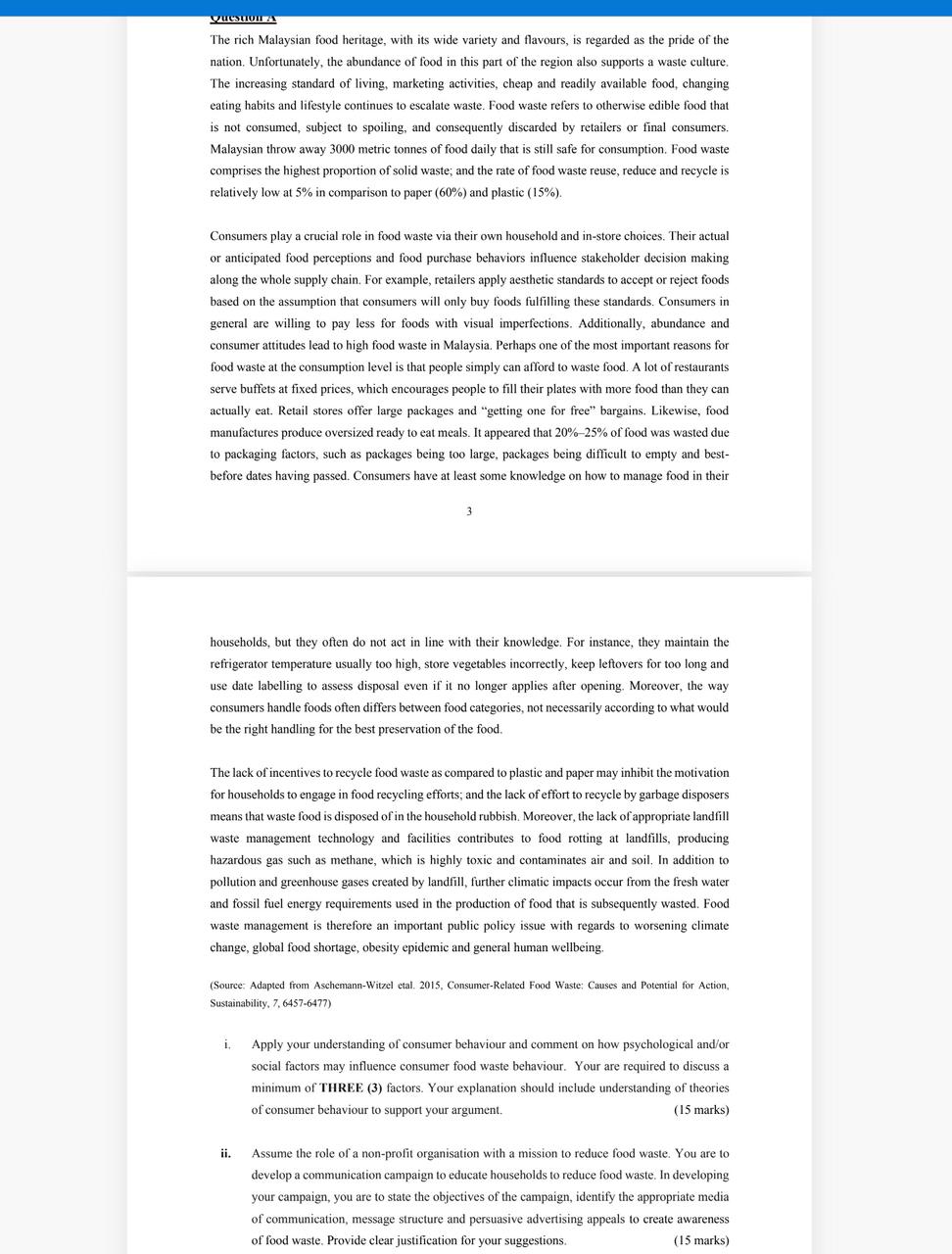Can I get Answer for these questions
The rich Malaysian food heritage, with its wide variety and flavours, is regarded as the pride of the nation. Unfortunately, the abundance of food in this part of the region also supports a waste culture. The increasing standard of living, marketing activities, cheap and readily available food, changing eating habits and lifestyle continues to escalate waste. Food waste refers to otherwise edible food that is not consumed, subject to spoiling, and consequently discarded by retailers or final consumers. Malaysian throw away 3000 metric tonnes of food daily that is still safe for consumption. Food waste comprises the highest proportion of solid waste; and the rate of food waste reuse, reduce and recycle is relatively low at 5% in comparison to paper (60%) and plastic (15%). Consumers play a crucial role in food waste via their own household and in-store choices. Their actual or anticipated food perceptions and food purchase behaviors influence stakeholder decision making along the whole supply chain. For example, retailers apply aesthetic standards to accept or reject foods based on the assumption that consumers will only buy foods fulfilling these standards. Consumers in general are willing to pay less for foods with visual imperfections. Additionally, abundance and consumer attitudes lead to high food waste in Malaysia. Perhaps one of the most important reasons for food waste at the consumption level is that people simply can afford to waste food. A lot of restaurants serve buffets at fixed prices, which encourages people to fill their plates with more food than they can actually eat. Retail stores offer large packages and "getting one for free" bargains. Likewise, food manufactures produce oversized ready to eat meals. It appeared that 20%-25% of food was wasted due to packaging factors, such as packages being too large, packages being difficult to empty and best- before dates having passed. Consumers have at least some knowledge on how to manage food in their households, but they often do not act in line with their knowledge. For instance, they maintain the refrigerator temperature usually too high, store vegetables incorrectly, keep leftovers for too long and use date labelling to assess disposal even if it no longer applies after opening. Moreover, the way consumers handle foods often differs between food categories, not necessarily according to what would be the right handling for the best preservation of the food. The lack of incentives to recycle food waste as compared to plastic and paper may inhibit the motivation for households to engage in food recycling efforts; and the lack of effort to recycle by garbage disposers means that waste food is disposed of in the household rubbish. Moreover, the lack of appropriate landfill waste management technology and facilities contributes to food rotting at landfills, producing hazardous gas such as methane, which is highly toxic and contaminates air and soil, In addition to pollution and greenhouse gases created by landfill, further climatic impacts occur from the fresh water and fossil fuel energy requirements used in the production of food that is subsequently wasted. Food waste management is therefore an important public policy issue with regards to worsening climate change, global food shortage, obesity epidemic and general human wellbeing. (Source: Adapted from Aschemann-Witzel etal. 2015, Consumer-Related Food Waste: Causes and Potential for Action. Sustainability, 7, 6457-6477) i. Apply your understanding of consumer behaviour and comment on how psychological and/or social factors may influence consumer food waste behaviour. Your are required to discuss a minimum of THREE (3) factors. Your explanation should include understanding of theories of consumer behaviour to support your argument. (15 marks) ii. Assume the role of a non-profit organisation with a mission to reduce food waste. You are to develop a communication campaign to educate households to reduce food waste. In developing your campaign, you are to state the objectives of the campaign, identify the appropriate media of communication, message structure and persuasive advertising appeals to create awareness of food waste. Provide clear justification for your suggestions. (15 marks)







